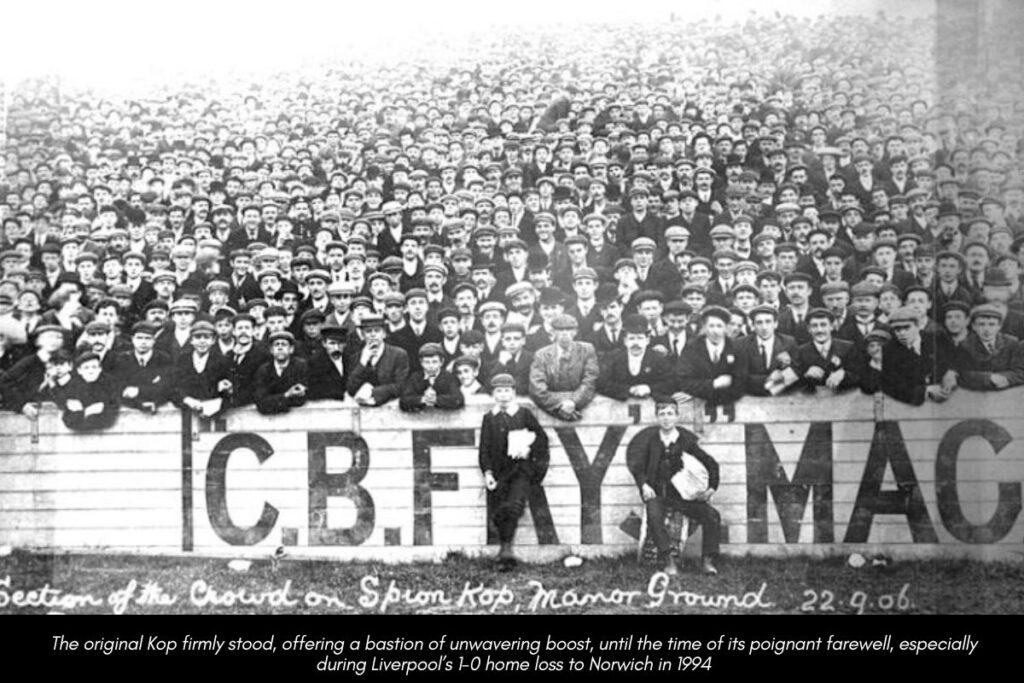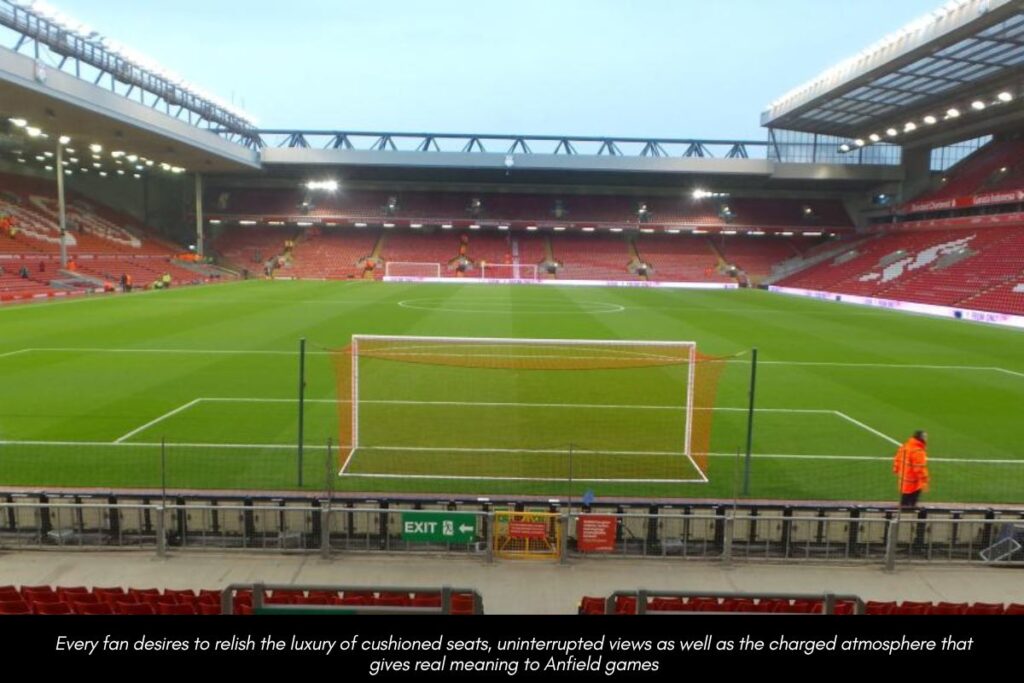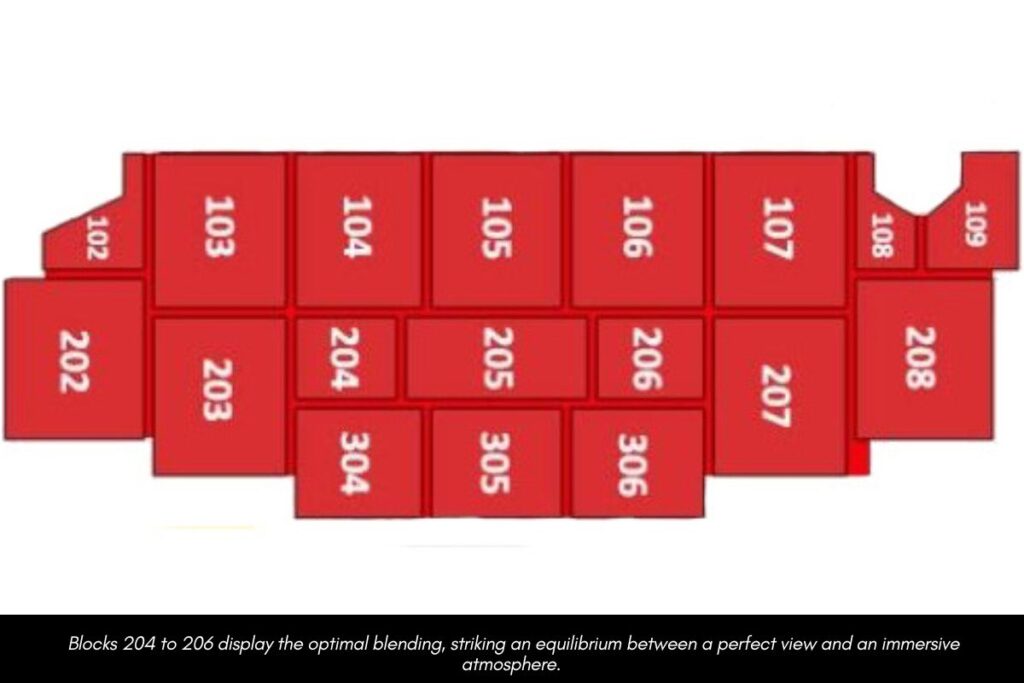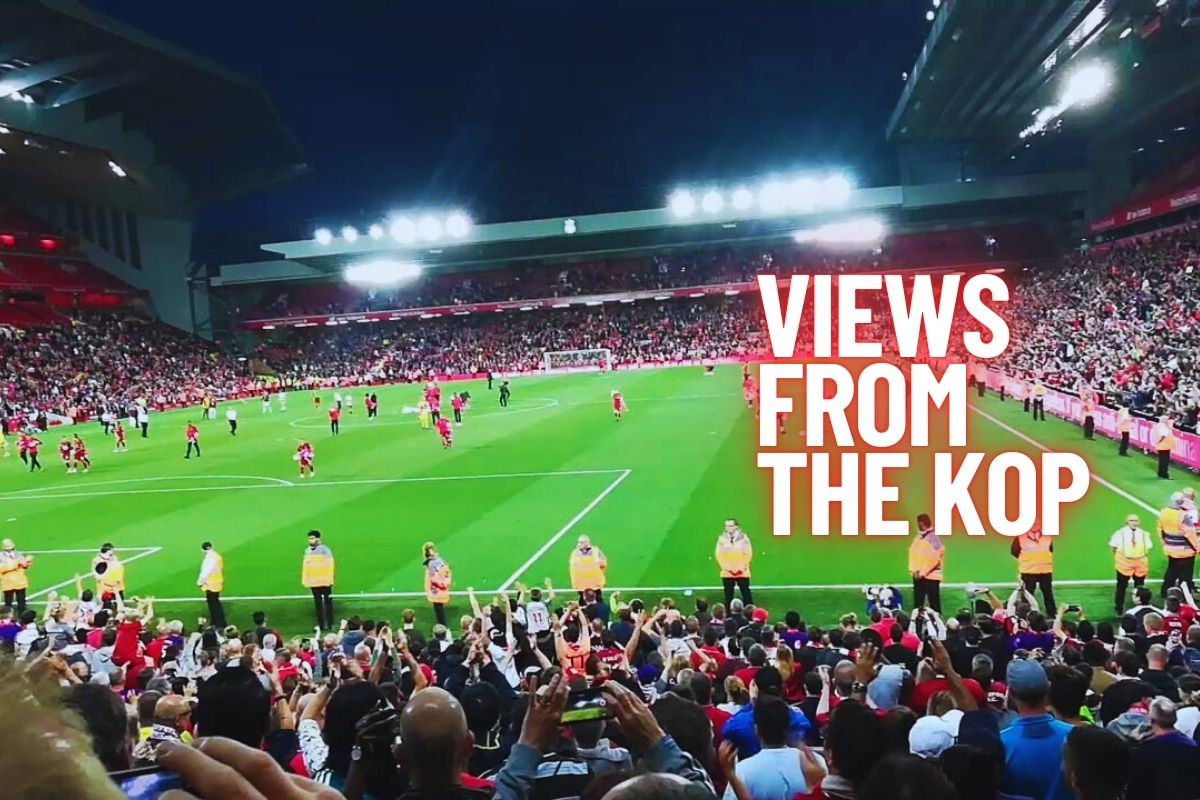The views from the Kop is an interesting topic to dive in but before we go in that direction let’s have a look at the brief history of the Anfield stand. The Kop is a persevering and inspiring symbol of soccer’s rich history. It’s a behemoth of passion and pride engraved within the soul of Anfield. Its history, integrated into the annals of Liverpool FC, spans over 100 years, incorporating the spirit and heritage that provide meaning to the entity. As the pulsating heartbeat of soccer days, the Kop has seen the ups and downs, triumphs and defeats, sculpting the club’s illustration.
- Read Also: See the Pitch: Views From Anfield Road Stand
Where did the Famous Kop get its Name?
Established in 1906 to celebrate the club’s second league championship, the Kop first took pride in the capacity that could host a maximum of 25,000 fans. However, over the years, the Kop transitioned into an imposing structure, touching its Zenith during the 1960s and 1970s, particularly when it became the hugest single section in Britain. The boisterous environment emerging from its confines became synonymous with Anfield stadium – causing a significant global prominence of Liverpool FC.
The roots of its identity go back to a poignant chapter in the club’s historical illustration. One of the examples is the Boer War in 1900. Soldiers from the British army, particularly those from Liverpool, fought tirelessly to get hold of the hilltop in South Africa. The hilltop was Spion Kop. The heated war claimed at least 300 lives in the British army. Paying homage to their fallen heroes, the survivors named the new stand at Anfield Stadium -the Kop. One of the well-known writers for the Liverpool Echo in 1906, gave a prediction that the name Kop would forever resonate when mentioning this specific stand and sacred hub.

The original Kop firmly stood, offering a bastion of unwavering boost, until the time of its poignant farewell, especially during Liverpool’s 1-0 home loss to Norwich in 1994. It was an event marked by Gerry Marsden’s rendition of “You’ll Never Walk Alone.” This was a poignant tribute to a season that was approaching expiration. The choice to disrupt and reestablish the Kop was feedback to the Taylor Report – which talked about the Hillsborough calamity in 1989. The brand new iteration, just like the predecessor, positions itself as a one-tier framework, put behind the goal adjacent to the Anfield Road End.
Resilience and Revival
When the Kop capacity was lowered to 12,850 due to the a-must shift to all-seated stadiums in 1994, the significance of bastion support remained. In 2021, 27 years since the Kop’s original final hurrah against Norwich, there was an implementation of the rail seating behind the stand. This was a trial focused on improving security and resurrecting the traditional standing habit. The stand reincarnation saw historic moments that attached themselves to the annals of soccer history. The Champions League semi-final wins against Chelsea, the historic 4-0 victory against Barcelona in 2019, and the anticipated League title event unfolded against the backdrop of the Kop’s unshaken loyalty.
The Covid-19 era might have limited the number of fans to Jordan Henderson’s historic shuffle with the League’s trophy. Nevertheless, the Kop’s motivation glowed far above the stadium. As the new Kop stand goes on to deliver its mandate in executing the electrifying atmosphere for which Liverpool fans are known, the hope flashes for numerous more unique memories to be integrated into the shadows of the historic stand. It’s a stand that not only displays a structure of bricks and cement but is a historic illustration of the forever legacy of the club. This is where the narrative, culture, and fervor of the supporters’ base meet to create an indomitable force.
Why is the Kop End so Famous?
The resonance of the Kop is unparalleled globally. Every fan desires to relish the luxury of cushioned seats, uninterrupted views as well as the charged atmosphere that gives real meaning to Anfield games. Nevertheless, such a coveted experience is not inclusive to several segments of the stadium. Having a full knowledge of the structure through the seating plan is important. It aids in the identification of the location of away spectators and the blocks thereof. For an optimal experience, it’s more important to realize the possible obstructed views that may mar your game experience.

Taking proactive measures through a close examination of the seating arrangement in the Kop stand is crucial. As a diehard fan, you can conduct a keen navigation through the seating plan, to select your desired point, then head to your row and seat. From such a practice you can bask in the glow and glory of the Kop’s special ambiance without interruption.
Views from the Kop: Best Seating Area at the Kop
Planted at the back of the Southern goal at the Stadium, the Kop gives a spectrum of seating alternatives. They cater to individual needs, tastes, and preferences for watching football head-on. The selection of your seats and the corresponding view hinges on someone’s inclination towards this unique perspective. Blocks 204 to 206 display the optimal blending, striking an equilibrium between a perfect view and an immersive atmosphere. Aligned further back, the views from the Kop will assist you in getting a comprehensive knowledge of the match while being nestled in the fervor of the most boisterous fans.

Blocks 304 to 306 are a representation of a remarkable alternative, though those located at the rearmost segment might face a slightly constraint view when the ball is airborne for an extended duration. At the front of the stand, Blocks 104 to 106 give a relatively unimpeded sight, yet the distance to the action may display difficulties, particularly in 105 where the goal itself can hinder the view line. Blocks 102, 108, and 109, situated at the sides of the stand, might face view interruptions because of the closer stands.
This may potentially restrict someone’s field vision – something that depends on the lateral positioning. Besides such nuances, the Kop stand remains a perfect selection that ensures the freedom of watching a game from the vantage point of European football’s most historic grandstand.
Conclusion
Selecting a seat in the Kop at the stadium is a nuanced decision, putting a balance on the distance to the action, visibility, and the immersive synergy of loyal fans. Block 204 to 206 emerge as the right choice for a maximized combination of view and atmosphere. Yes, blocks 304 to 306 may provide a similar experience, however, caution is given at the back due to possible view hindrances. The front row selections in blocks 104-106 give closeness to the heated match. Nevertheless, the goal might obstruct views. All said and done, the views from the Kop stand remain a historic grandstand that promises a thrilling and memorable experience in English soccer for all fans.
Stay tuned for more updates on Liverpool FC Times and Stories. Your thoughts are always welcome in the comments section. Thank you for your continued support!
YNWA (You’ll Never Walk Alone)!
The Liverpool FC Times Team
LiverpoolFCTimes.com

Your article helped me a lot, is there any more related content? Thanks!
Your article helped me a lot, is there any more related content? Thanks!